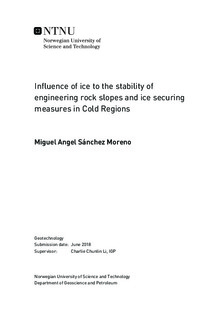Influence of ice to the stability of engineering rock slopes and ice securing measures in Cold Regions
Master thesis
Permanent lenke
http://hdl.handle.net/11250/2574027Utgivelsesdato
2018Metadata
Vis full innførselSamlinger
Sammendrag
In cold regions, freezing is an important factor for weathering processes in rock slopes. Thepresence of ice in discontinuities can contribute to maintain the stability of rock slopes. Butdegrading permafrost and thawing cycles can be considered an important factor for rock slopefailures in arctic environments (Michael et al. (2012)). The project aims to the influence of iceand thawing to the stability of a rock cut rock slope or another type of engineering rock slope.The cycle of ice and thawing will periodically change the stress state in the rock mass and gradually changes the rock physical and mechanical properties, such as weathering and weakeningof the rock mass in the long run.Davies et al. (2000) showed through direct shear box test that the stiffness and strength ofan ice filled joint are a function of normal stress and its temperature. Results revealed that ajointed rock slope that is stable without ice in the joints and is also stable when ice is presentat low temperatures will become unstable as the ice thaws. A direct impact of icing to the rockmass is the frost weathering in rock discontinuities which may influence the stability of an engineering slope in joint rock masses. Water pressure and volumetric expansion near rock surfaceinfluence the rock slope stability due to shear stresses and reducing its resistance.Preventing measures from literature and commonly used in Norway are presented Norem(1998). Later four case studies are displayed, showcasing different locations in cold regions. Thecase studies expose the ice problems defined and helps to define the models used. Two simplified cases of possible rock slopes are modeled to account for the ice filled fractures and supportthe assumptions based on literature. RocPlane 3.0, RocTopple 1.0 and Phase2 9.0 have beenused to evaluate a planar sliding failure and a toppling failure in rock slopes. The models aimto show the ice induced forces as destabilizing forces that could compromise the stability of aspecific wedge which can lead to an induce failure of the rock slope.Rock slopes become unstable driven by changes in temperature and precipitation conditions. Generally, destabilization on rock slopes tends to occur on thawing periods. Hence,critical slope stability results are expected in warm frozen areas where both ice and water arepresent. Ice exerts certain force on joint rock slopes and can induce failure in the jointed rockmass.
